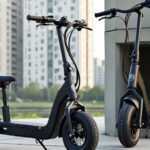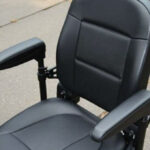Navigating California’s Ebike Laws: What You Need to Know
If you’re curious about ebike laws in California, you’re in the right place. California has specific rules and regulations that help keep you and others safe while riding. Whether you’re commuting or exploring new trails, understanding these laws is key to a smooth ride. Here’s a quick breakdown:
Quick Facts:
- No license or registration required: You don’t need a driver’s license or registration.
- Follow traffic laws: Just like traditional bikes, obey stop signs, traffic signals, and speed limits.
- Class distinctions: Different rules apply to Class 1, Class 2, and Class 3 ebikes.
California’s Assembly Bill 1096, passed in 2015, made significant updates to accommodate the growing popularity of ebikes. This bill outlines the definitions and regulations for different classes of electric bikes. According to the California Vehicle Code, an ebike is equipped with fully operable pedals and an electric motor not exceeding 750 watts. It must also adhere to a speed limit of 28 mph on level ground.
Understanding these distinctions helps ensure that you’re riding legally and safely. Let’s dig deeper into what each class means, the specific rules you must follow, and where you can ride your ebike in California.

Ebike laws in california terms made easy:
Understanding Ebike Classifications
California classifies ebikes into three categories: Class 1, Class 2, and Class 3. Each class has its own rules and features, which affect where and how you can ride. Knowing your ebike’s class is crucial for staying compliant with ebike laws in California.
Class 1 Ebikes
Class 1 ebikes are pedal-assist bikes. This means the motor only provides assistance when you are pedaling. The motor stops assisting once the bike reaches 20 mph.
- Top Speed: 20 mph
- Motor Type: Pedal-assist only
- Age Restriction: None
Class 1 ebikes are the most similar to traditional bicycles and can be used on most bike paths and trails where regular bikes are allowed. They are perfect for casual riders and those new to ebikes.
Class 2 Ebikes
Class 2 ebikes offer both pedal-assist and throttle-assist. The throttle feature means you can get a boost without pedaling. However, like Class 1, the motor assistance stops at 20 mph.
- Top Speed: 20 mph
- Motor Type: Pedal-assist and throttle-assist
- Age Restriction: None
Class 2 ebikes are versatile and great for urban commuting. They allow riders to take a break from pedaling while still moving forward.
Class 3 Ebikes
Class 3 ebikes are the fastest of the three classes. These bikes are pedal-assist only, but the motor assists up to 28 mph. Due to their higher speed, they come with additional regulations.
- Top Speed: 28 mph
- Motor Type: Pedal-assist only
- Age Restriction: 16 and older
- Helmet Requirement: Mandatory for all riders
Class 3 ebikes are ideal for those who need to cover longer distances quickly. They are often used for commuting and are allowed in bike lanes but are restricted from bike paths and trails unless local authorities permit it.
Key Takeaways
- Motor Wattage: All classes must have a motor of less than 750 watts.
- Speed Limits: 20 mph for Class 1 and 2; 28 mph for Class 3.
- Pedal-Assist vs. Throttle-Assist: Only Class 2 bikes can use a throttle; Class 1 and 3 rely solely on pedal-assist.
- Age and Helmet Requirements: No age restriction for Class 1 and 2; Class 3 riders must be 16+ and wear a helmet.
Understanding these classifications will help you choose the right ebike for your needs and ensure you’re following the law. Next, we’ll dive into the general regulations you need to know when riding an ebike in California.
General Ebike Regulations in California
Road Rules for Ebikes
When riding an electric bike in California, follow the same traffic laws as traditional bicycles. This means stopping at stop signs, obeying traffic signals, and adhering to speed limits. Here’s a quick rundown:
- Stop Signs and Traffic Signals: Just like cars, ebikes must come to a complete stop at stop signs and obey all traffic lights.
- Speed Limits: Class 1 and Class 2 ebikes have a top speed of 20 mph, while Class 3 ebikes can go up to 28 mph. Always stay within these limits.
- Right of Way: Ebike riders must yield to pedestrians and other vehicles as required by law.
One key advantage of riding an ebike in California is that you do not need a driver’s license. There’s also no need for registration, insurance, or license plates. This makes ebikes a convenient and accessible mode of transportation.
Equipment Requirements
California law has specific requirements for ebike equipment to ensure safety:
- Operable Pedals: All ebikes must have fully operable pedals. This means you should be able to pedal your bike like a traditional bicycle.
- Motor Disengagement: The motor on your ebike must disengage when you apply the brakes. This is a crucial safety feature.
- Brake Functions: Ebikes must have functional brakes that allow you to stop your bike safely and effectively.
By adhering to these regulations, you can ensure a safer riding experience and stay compliant with ebike laws in California.
Next, we’ll explore where you can ride your ebike, including bike lanes, paths, and trails.
Where You Can Ride Your Ebike
Bike Lanes and Paths
In California, the type of ebike you have determines where you can ride it. Here’s a breakdown:
- Class 1 and Class 2 Ebikes: These ebikes can be ridden in bike lanes and on bike paths, just like regular bicycles. You can also ride them on multi-use paths unless a sign specifically prohibits electric bikes.
- Class 3 Ebikes: These are restricted to bike lanes that are adjacent to roadways and cannot be used on bike paths or trails unless local authorities allow it. Always check local ordinances for specific permissions.
Local Ordinances: Some cities and counties have their own rules about where you can ride ebikes. For example, many downtown areas prohibit riding any type of bike on sidewalks. Always look for signs and be aware of local regulations to avoid fines.
Trails and Recreational Areas
When it comes to trails and recreational areas, the rules can vary significantly:
- State Parks: In California State Parks, Class 1 and Class 2 ebikes are generally allowed where regular bicycles are permitted, unless a specific trail prohibits them. Notable state parks where these ebikes are allowed include Wilder Ranch State Park and Folsom and Auburn State Recreation Areas. Always check with the park authorities before heading out.
- Federal Lands: As of August 29, 2019, ebikes up to 750 watts can be used on federal lands wherever regular bicycles are allowed. However, this does not yet apply to National Forests, which are managed by the Department of Agriculture. For the most up-to-date information, contact the US Forest Service Pacific Southwest Regional Office or the BLM California State Office.
Specific Prohibitions: It’s crucial to note that some trails and natural areas may have specific prohibitions against ebikes. Always check the rules for each trail or park you plan to visit to ensure compliance.
By understanding these regulations, you can enjoy your ebike responsibly and legally across California’s beautiful landscapes.
Next, we’ll look into safety and helmet laws to keep you protected while riding.
Safety and Helmet Laws
Helmet Requirements for Different Classes
In California, helmet requirements for ebikes vary based on the class of the ebike:
-
Class 1 and Class 2 Ebikes: There are no specific helmet requirements mandated by state law for riders of Class 1 and Class 2 ebikes. However, it’s always a good idea to wear a helmet for your safety.
-
Class 3 Ebikes: Helmets are mandatory for all riders. This is because Class 3 ebikes can reach speeds up to 28 mph, making the risk of injury higher. Riders must wear a bicycle safety helmet that meets the standards set by the Consumer Product Safety Commission (CPSC). Look for a helmet with a DOT sticker, which indicates it meets safety standards.

Age Restrictions: Only riders aged 16 and older are allowed to operate Class 3 ebikes. This restriction is in place to ensure that younger, less experienced riders are not exposed to the higher speeds and potential risks associated with these ebikes.
Safety Tips for Ebike Riders
Riding an ebike can be a fun and efficient way to get around, but safety should always be a priority. Here are some key safety tips to keep in mind:
-
Speed Awareness: Always be aware of your speed, especially when riding in areas with pedestrians or other cyclists. Class 3 ebikes can go up to 28 mph, which can be dangerous in crowded areas.
-
Pedestrian Safety: When riding on multi-use paths, always yield to pedestrians. Slow down and use a bell or horn to alert them of your presence.
-
Impact Force: The faster you go, the greater the impact force in the event of a crash. Wearing a helmet and appropriate protective gear can reduce the risk of serious injury.
-
Visibility: Make sure you are visible to other road users. Use lights and reflectors, especially when riding at dawn, dusk, or night. Wearing bright or reflective clothing can also help.
-
Brake Functions: Ensure your ebike’s brakes are in good working condition. Regularly check and maintain your brakes to avoid accidents.
By following these safety tips and understanding the helmet requirements, you can enjoy a safer riding experience on your ebike.
Next, we’ll answer some frequently asked questions about ebike laws in California.
Frequently Asked Questions about Ebike Laws in California
Are electric bikes street legal in California?
Yes, electric bikes are street legal in California. According to California Assembly Bill No. 1096, electric bicycles are treated the same as traditional bicycles under California law. This means they can be ridden on streets and must follow the same rules of the road as regular bicycles. However, there are specific regulations depending on the class of the ebike you are riding.
Are 750 watt Ebikes legal in California?
Yes, 750 watt ebikes are legal in California. The California Vehicle Code allows electric bikes with motors up to 750 watts. These ebikes must also have fully operable pedals and must not exceed 28 mph on level ground. Modifying your ebike to exceed these specifications can change its classification, potentially requiring a motorcycle license and other legal requirements.
Are helmets required for e-bikes in California?
Whether you need to wear a helmet while riding an ebike in California depends on the class of the ebike and the rider’s age:
-
Class 1 and Class 2 Ebikes: Helmets are not legally required for riders aged 18 and older. However, it is strongly recommended to wear a helmet for safety. Riders aged 17 and under must wear a helmet.
-
Class 3 Ebikes: Helmets are mandatory for all riders, regardless of age. This is due to the higher speeds (up to 28 mph) these bikes can reach, increasing the risk of injury. The helmet must meet the standards set by the Consumer Product Safety Commission (CPSC) and should have a DOT sticker indicating it meets federal safety standards.
By understanding these frequently asked questions and their answers, you can ensure you are riding your ebike legally and safely in California.
Conclusion
In summary, understanding the ebike laws in California is crucial for safe and legal riding. Ebikes are classified into three categories—Class 1, Class 2, and Class 3—each with specific regulations regarding speed, age restrictions, and where they can be ridden. Class 1 and 2 ebikes are generally allowed in bike lanes and paths, while Class 3 ebikes have more restrictions and require helmets for all riders.
At Doot Scoot, we are committed to fostering a strong community of ebike enthusiasts. We believe that staying informed about local laws and regulations is essential for everyone’s safety and enjoyment. Our tools and resources are designed to help you steer these laws effortlessly.
Community Building and Customer Support
We are more than just a company; we are a community. We offer virtual and in-person classes to help you get the most out of your ebike experience. Whether you’re a beginner or an experienced rider, our training programs are custom to meet your needs.
Our customer support team is always here to help. If you have any questions about ebike laws, need assistance with your bike, or want to explore new riding areas, don’t hesitate to reach out.
Innovation
Innovation is at the heart of what we do. We are continuously working on new ways to improve your riding experience. From state-of-the-art ebike accessories to advanced safety features, we aim to keep you ahead of the curve.
By staying up-to-date with the latest regulations and advancements, we ensure that our products and services are not only compliant but also push the boundaries of what’s possible in electric bicycles.
Thank you for choosing Doot Scoot. Together, let’s ride towards a safer, more informed, and innovative future.

For more information, check out our comprehensive tools and resources page.










